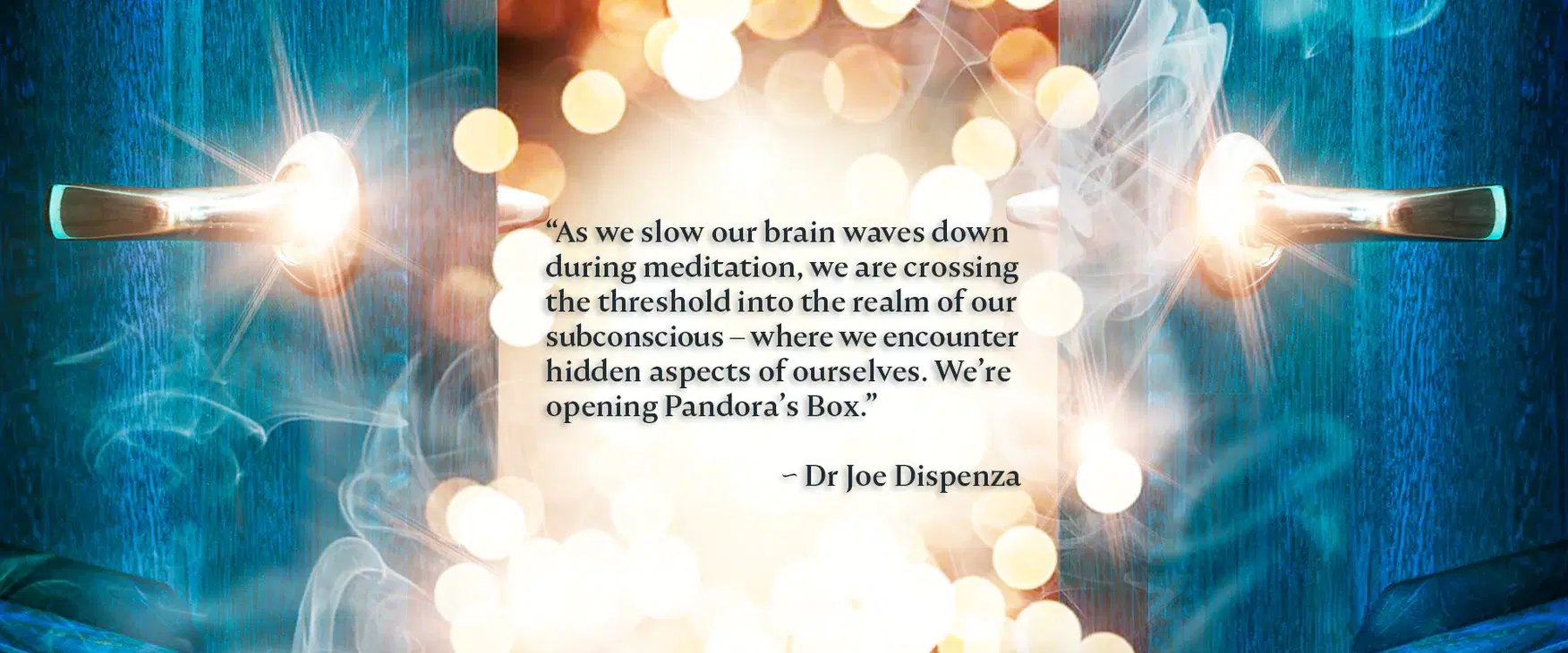Opening Pandora’s Box, Part I:
Crossing the Threshold
Dr Joe Dispenza | 01 July 2022
Recently, we’ve been getting a lot of inquiries about a common topic. Notes have come in to our team at Dr Joe Live – my monthly conversations with students around the world – and to our Customer Service team, which helps our community members with questions and problem-solving.
“I’m new to the work,” some queries begin. Or, “I’ve been practicing my meditations every day, and …”
- “My question is about dreams. What do they mean? And is it possible to change them?”
- “I’m having trouble with menacing human faces and figures … Are there ways to understand and get past the images without quitting?”
- “I keep having the strangest nightmares. I wake up from them and go back to sleep and they just take back up where they left off. Have you ever had such an experience – and what might be an explanation?”
Even though our students come from vastly different backgrounds, this happening is common to many. Our letter-writers – usually people who are relatively new to the work; in early stages of practice – are beginning to encounter unfamiliar energy and entities, often in dreams, and are seeking to understand their experience.
This is the stage of the work I often refer to as “Opening Pandora’s Box.” If you’re familiar with the Greek myth, Pandora is given a box by the gods and warned never to open it. But she can’t deny her intense curiosity, and when she opens the mysterious box, she releases what have come to be perceived primarily as punishments – hardships; illnesses; worries – before she rushes to close the lid, keeping hope safely contained.
I say “perceived” because, over time, the telling of this myth has become decidedly influenced by a negative bias. But the lesson of Pandora’s Box is really about the gifts of insight that are possible when we withhold judgement – and stay open and curious.
And that’s a perfect lesson for any stage of this work, particularly when we come up against the uncomfortable and the unknown.
… Into New Frontiers
When we begin this work, seated meditation is one of the first frontiers we cross into. For the first time in our lives, we learn how to change our brain waves while we're sitting up – in other words, not in our usual way of lying down and passing through each stage until we fall asleep and begin dreaming.
(If you want to understand this process better, I wrote a two-part blog series on brain waves and meditation. You can find part I here – and part II here.)
In seated meditation, we practice relaxing while remaining awake; opening our awareness and attention to space. We learn to settle down our analytical mind and open the door between our conscious and subconscious minds.
And as we get better and better at this, our automatically programmed thoughts and feelings – long-term memories; highly charged emotional experiences; things that have long been buried in our subconscious – begin to stir and surface.
Now, we’re crossing the threshold into the realm of our subconscious – where we encounter hidden aspects of ourselves; unknown to us in waking life. We’re opening Pandora’s Box.
As these memories and experiences rise to the surface, we often experience vivid dreams or visions that can seem frightening and dark. And it’s confusing, because the associated energy seems counter to the enlightened state we’re trying to cultivate.
This is quite common in early stages of practice. Some people see faces or disembodied entities. Others hear voices. Some experience recurring nightmare visions; a loop of imagery they can’t seem to break. And some are so troubled by what they see and experience, they’re tempted to quit.
But when the work seems hardest and most uncomfortable is when it matters most to stay with it.
What Our Emotions Are Trying to Tell Us
This is when it’s vitally important not to judge – and not to over-analyze. When we must commit to remaining open and curious. Because these experiences aren’t good or bad. They’re simply information … coming from somewhere. Something is trying to get our attention. It’s the subconscious mind that’s showing us “something” that’s stored there. Something that’s trying to surface.
Therefore, when these dreams and visions arise, the subconscious – where these “programs” are stored – is trying to vent information equal to the emotion. That means the emotion we feel during these experiences is the key to understanding what our hidden self wants us to know.
Our implicit emotional response is what’s driving these experiences. The emotion is the energy that keeps fueling the experience of the dream – and attracting the entities, weird loops, and faces we repeatedly encounter.
So when we have these experiences, it’s important to notice what we feel – whether it's fear, sadness, hostility, or anger. The emotions associated with our dreams are cues from our subconscious; cues that tell us what we need to work on and overcome. More than likely, they’re feelings carried over from our daily lives; feelings we repeatedly experience – and automatically act out – but are unconsciously unaware of. That’s what makes them “subconscious.”
These emotions and programs are what our dreams and lucid visions are inviting us to examine and understand. Many of us are afraid to look closer. But if we do, there’s an opportunity to learn about ourselves – and grow – and transcend. Like most aspects of this work, when we overcome the emotion, we overcome the experience.
I’ll talk more about that in Opening Pandora’s Box, Part II.

Comments